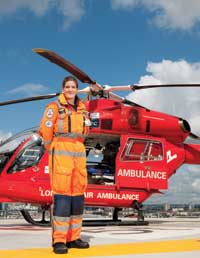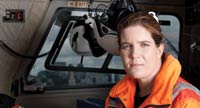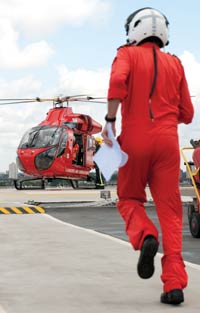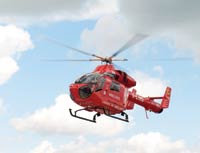Life savers in the sky: flying doctors Understand article
Anne Weaver, lead clinician for London’s Air Ambulance, tells Marie Mangan about her job: saving lives.

Image courtesy of Iain
Crockart,
www.iaincrockart.com
Anne Weaver regularly sees Lucy, 14, at fundraising events for London’s Air Ambulancew1 in the UK. What is remarkable is that seven years ago, Lucy almost died from massive multiple injuries after she was hit by a jeep while running across the road to go to the park. She had head and facial injuries so severe that blood pumped into her airway and stopped her breathing.
Anne, a doctor with London’s Air Ambulance, recalls: “We were on scene in nine minutes. There was a doctor desperately trying to manage Lucy’s airway, with the help of the ambulance crew, but there was so much blood it was impossible to control. She wasn’t breathing. We gave her an emergency anaesthetic, released the pressure in her collapsed and bruised lungs with surgical holes in the chest cavity, packed her face and then flew her back to hospital.”
There, Lucy had almost 12 hours of surgery to reconstruct her face, followed by three months in intensive care. “This was the moment that made it totally clear to me why we do this job,” Anne says. “I now see a girl who is enjoying being a teenager but I know that she was snatched from death by the quick work of the doctor in the park and then our critical interventions at the scene and in hospital.”
Anne has been the lead clinician for London’s Air Ambulance since 2007. The service, now more than 20 years old, pioneered the concept of trauma-trained doctors and paramedics treating critically injured patients at the scene and taking them to a hospital that specialises in trauma.

Crockart,
www.iaincrockart.com
“When I started with London’s Air Ambulance, it felt a bit like trying to pass your driving test: there were so many things to consider. I remember thinking I was never going to manage it all. You are the only doctor on the scene and making the right decisions rests on your shoulders. That’s why the training is so thorough. The doctors we recruit are always senior doctors and they spend the first month of their six-month placement working alongside one of the existing doctors who will be training them, de-briefing them after every mission, challenging, questioning, supporting them.
“As lead clinician, I am responsible for the day-to-day running of the service, making sure the doctors and paramedics are trained, maintain their skills and are supported. I run twice-weekly case review sessions with the whole team where we challenge and learn from each other.
“When they are on duty, team members can call day or night for guidance or to discuss the best course of action for a patient. The service has a good reputation internationally and I need to ensure we not only maintain our high standards but also stay ahead of the game using cutting-edge technology and techniques. It’s a challenging role and there are never enough hours in the day!”
One day that is still clearly imprinted in Anne’s memory is 7 July 2005, the day that suicide bombers attacked four locations on London’s tube and bus networks.
“It was so surreal,” Anne says. “I was in a meeting with 16 past and present air ambulance doctors, something we do once a month. The chief pilot must somehow have been aware of something awry and said that we should all get our flight suits on. It seemed ridiculous at the time for 16 of us to get ready when normally only one doctor is on duty, but minutes later a major incident was declared.”

Crockart,
www.iaincrockart.com
The helicopter and cars ferried the medical teams to the four London locations – Aldgate, King’s Cross, Edgware Road and Tavistock Square. Anne, as lead clinician, was responsible for organising the effort.
“I remember standing in the operations room on the helipad, looking over London and feeling sick and guilty that I was sending my friends and colleagues out into dangerous situations.
“I thought I was going to get a call to say that a doctor or paramedic had been killed if another device detonated. I knew that if I hadn’t done the organisation at the start, we wouldn’t have had people in the right places. But it was a relief to then go to King’s Cross myself and do what I felt I was meant to do in this situation: be a doctor. Later that day, the chief executive gathered 400 staff from the hospital and air ambulance service together to de-brief. It was an amazing feeling of camaraderie. Everyone had pulled together and we felt very emotional about the events. We knew we had provided a good service for patients that day.”
So how did Anne’s interest in medicine start? It was sparked in the last two years of school, when she attended a course at the Queen’s Medical Centre, where the University of Nottingham’sw2 medical school is based.

Image courtesy of Iain
Crockart,
www.iaincrockart.com
“The medical school was an integral part of the hospital and had a really clinical feel. Unlike other medical schools where you spend your first two years in lectures, from week one you were allowed to see patients. Being in a medical environment, surrounded by doctors who were constantly inspiring you, you were reminded of why you were doing so many exams!
“I remember my first day at university so clearly. I really enjoyed meeting people from different courses; on my floor in the hall of residence, we had art history, theology, philosophy and engineering students. We became like a little family. When I was revising for medical exams, they made me tea at three in the morning.
“So many of my tutors inspired me. Seeing one of them, Dr Demas Esberger, in action just weeks after I started at university was a landmark moment. It was 5 November 1990 and I was in the accident and emergency department. Two boys, both very badly injured in a car accident, were brought in. I was shaking and thinking I was so glad I was not qualified, as I would have had no idea where to start.
“I was in awe of Dr Esberger and the team and from that moment, I wanted to be able to do what they did. Officially, you only did two weeks in accident and emergency as a medical student but I think I spent every available waking moment there. They couldn’t get rid of me! Later in my training, I made sure I chose placements that would enable me to help these patients.” One of those placements was a six-month stint with London’s Air Ambulance, which sowed the seeds of Anne’s future career.
Today, Anne juggles her air ambulance responsibilities with being a senior doctor (consultant) in accident and emergency. She also finds time to be a trustee of the air ambulance’s charity. The service is partly funded by the UK National Health Service and corporate sponsors but still has to find £1.2 million a year from charitable donations. “We are feeling the impact of the recession. We now have to have contingencies to reduce the service when what we really want to do is increase it. It’s frustrating.”
Current challenges aside, Anne does not take her achievements for granted. “It is a great privilege to head the service that is on call for 11 million people in London.”
Acknowledgement
The original version of this article was published in Alumni Exchangew4, the alumni magazine of the University of Nottingham, UK.
Web References
- w1 – To learn more about London’s Air Ambulance, see: www.londonsairambulance.com
- w2 – For more information about Nottingham University, see: www.nottingham.ac.uk
- w3 – Barts and The London NHS Trust manages three leading London hospitals: St Bartholomew’s (Barts) in the City, The Royal London in Whitechapel and The London Chest in Bethnal Green. To learn more, visit: www.bartsandthelondon.nhs.uk
- w4 – Alumni Exchange, the alumni magazine of the University of Nottingham, is freely available to download. See: www.alumni.nottingham.ac.uk
Review
This is an inspiring story describing a profession that combines some truly wonderful traits: medical service, emergency treatment, dedication to helping people in need, and flying. Anne Weaver, the clinician being interviewed, is enthusiastic about her job and through some of her memories, she passes this enthusiasm on to the reader.
The article is very interesting and easy to read. It could be read in any classroom (science or not) and at any level (even elementary school). It is not an article to teach with but one to inform and inspire – and not only at school. Perhaps policy makers in other cities and countries that do not have similar flying doctor programmes should read it and think about adopting such practices.
Michalis Hadjimarou, Cyprus





